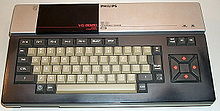Loading AI tools
From Wikipedia, the free encyclopedia
The VG-8020 was Philips' third MSX computer introduced in 1984, after the VG-8000 and the VG-8010 computers.[1][2][3][4]
 | |
| Developer | Philips |
|---|---|
| Manufacturer | Kyocera |
| Type | home computer |
| Release date | 1984 |
| Operating system | MSX BASIC 1.0 |
| CPU | Zilog Z80A @ 3.56 MHz |
| Memory | 64 KB |
| Removable storage | data recorder, cartridge |
| Display | RF output, CVBS: 256 × 192 pixels, 16 colors |
| Graphics | TMS9929A |
| Sound | AY-3-8910 |
| Controller input | Joystick |
| Backward compatibility | MSX1 |
| Predecessor | Philips VG-8010 |
With a price of 2990 Fr,[4] the machine was MSX1 standard compatible, had a real keyboard (instead of a chiclet keyboard like its predecessors) and a printer port (missing on the previous models).
The VG-8020 was manufactured by Kyocera[5] and featured a Zilog Z80A microprocessor clocked at 3.56 MHz, 64KB of RAM, 16KB of VRAM, two cartridge slots and two joystick ports.[3][4]
The machine came with MSX BASIC 1.0 in ROM and graphics were provided by a Texas Instruments TMS9929A, with RF and composite video outputs. Sound was generated by a General Instruments AY-3-8910 chip.
It was replaced by the VG-8220, a MSX2 compatible machine.[4]
The computer was marketed in several variants:[1][5][6][7][8]
Seamless Wikipedia browsing. On steroids.
Every time you click a link to Wikipedia, Wiktionary or Wikiquote in your browser's search results, it will show the modern Wikiwand interface.
Wikiwand extension is a five stars, simple, with minimum permission required to keep your browsing private, safe and transparent.